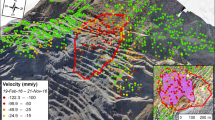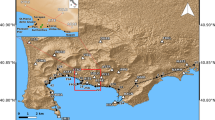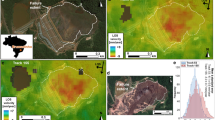Abstract
GROUND-BASED measurements of volcano deformation can be used to assess eruptive hazard, but require the costly (and often hazardous) installation and maintenance of an instrument network. Here we show that spaceborne radar interferometry, which has already shown its utility in mapping earthquake-related deformation1, can be used to monitor long-term volcano deformation. Two families of synthetic aperture radar images, acquired from ascending and descending orbits by the satellite ERS-1, and looking at Mount Etna from opposite sides, cover the time period from 17 May 1992 to 24 October 1993, and include the second half of Etna's most recent eruption. Despite artefacts of the interferometric technique, we can observe a volcano-wide deflation, which is an expected consequence of the eruption, but which had not previously been appreciated. We quantify it using a simple model based on the change of pressure in a sphere located in an elastic half-space; the modelled deformation increases linearly with time until the end of the eruption. Our results show that it will be possible to use this technique to detect the inflation of volcanic edifices that usually precedes eruptions.
This is a preview of subscription content, access via your institution
Access options
Subscribe to this journal
Receive 51 print issues and online access
$199.00 per year
only $3.90 per issue
Buy this article
- Purchase on Springer Link
- Instant access to full article PDF
Prices may be subject to local taxes which are calculated during checkout
Similar content being viewed by others
References
Massonnet, D. et al. Nature 364, 138–142 (1993).
Villari, L. (ed.) Acta vulcanol. 4, 1–177 (1994).
Global Volcanism Network Smithsonian Inst. Bull. 16(17)–18(5) (1991–1993).
Goldstein, R. M., Engelhardt, H., Kamb, B. & Frolich, R. M. Science 262, 1525–1530 (1993).
Zebker, H. A., Rosen, P., Goldstein, R. M., Gabriel, A. & Werner, C. L. J. geophys. Res. 99, 19617–19634 (1994).
Feigl, K. L., Sergent, A. & Jacq, D. Geophys. Res. Lett. (in the press).
Massonnet, D. & Feigl, K. L. Geophys. Res. Lett. (in the press).
Massonnet, D. & Rabaute, T. IEEE Trans. Geosci. Rem. Sensing 31, 455–464 (1993).
Murray, J. B. J. Volcanol. geotherm. Res. 35, 121–139 (1988).
Mogi K. Bull. Earthquake Res. Inst. Tokyo 36, 34–134 (1958).
Nunnari, G. & Puglishi G. Acta vulcanol. 4, 101–107 (1994).
Bonaccorso, A., Velardita, R. & Villari, L. Acta vulcanol. 4, 87–96 (1994).
Author information
Authors and Affiliations
Rights and permissions
About this article
Cite this article
Massonnet, D., Briole, P. & Arnaud, A. Deflation of Mount Etna monitored by spaceborne radar interferometry. Nature 375, 567–570 (1995). https://doi.org/10.1038/375567a0
Received:
Accepted:
Issue Date:
DOI: https://doi.org/10.1038/375567a0
This article is cited by
-
A review on advances in persistent scatterer interferometry and proposing a novel method for phase optimization of distributed scatterers pixels
Journal of Engineering Mathematics (2024)
-
Dynamically estimating deformations with wrapped InSAR based on sequential adjustment
Journal of Geodesy (2023)
-
ADTC-InSAR: a tropospheric correction database for Andean volcanoes
Scientific Data (2022)
-
Measurement of surface deformation related to the December 2018 Mt. Etna eruption using time-series interferometry and magma modeling for hazard zone mapping
Geosciences Journal (2022)
-
Sand liquefaction during the 2021 M 7.4 Maduo earthquake, China
Natural Hazards (2022)
Comments
By submitting a comment you agree to abide by our Terms and Community Guidelines. If you find something abusive or that does not comply with our terms or guidelines please flag it as inappropriate.



